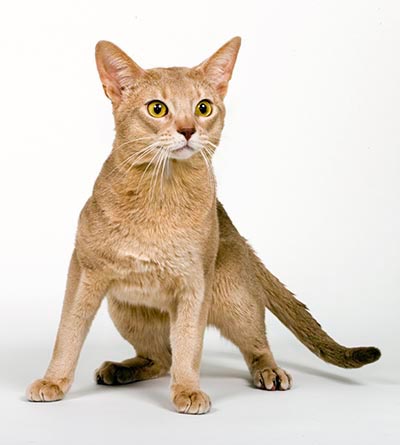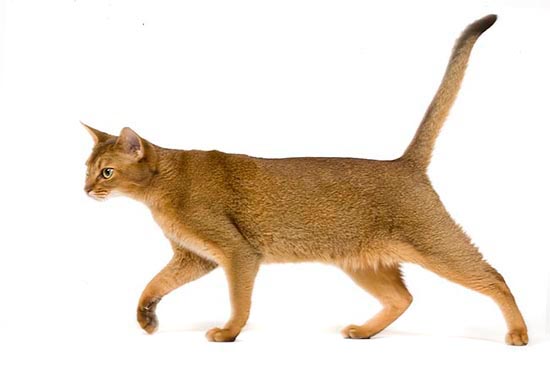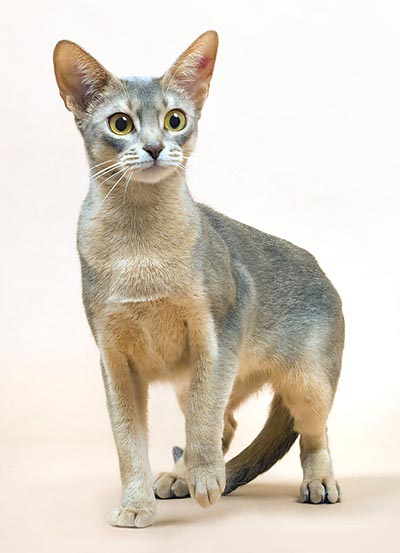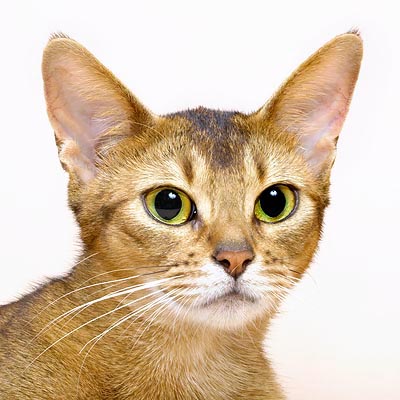Family : Felidae

Text © Dr Didier Hallépée

English translation by Mario Beltramini

Rapid, greedy, explorer, climbing everywhere © Giuseppe Mazza
Later on, an English lady travelled around in Abyssinia looking for authentic Abyssinian cats. She found none, and that was right.
The typical mantle of the Abyssinian recalls that of a hare: each hair has two or three stripes of colour: this is called the ticking. After the studies done on the origins of the feline breeds, it looks like that the ticking comes from the South-eastern Asia regions.
For a long while, semi-long hair kitten appeared in the litters of Abyssinians and were systematically cast aside because not conform. In 1965, an American breeder decided to create with them a new breed, recognized in 1972 as Somali.
Character
The Abyssinian has longer back legs which give it an inimitable feline harmony. Its very feline look makes it a favourite by the public. The nose is surrounded by a fascinating edge and the face has a magnificent make-up around the eyes and on the forehead. Muscled, sportive, very affectionate, it does not mew, but coos. Speedy, greedy, curious (attention to the flights), climbing everywhere, it’s a very lively companion (not to be recommended for those who are mistaking a cat with a decorative object), with a regal look. Medium-shaped, the males are proportionally bigger than the females.
Even if muscled, the Abyssinian and the Somali are agile and supple like a panther and show a great interest for what is around them. Their ticketed mantle has a quality which reflects the light. After the length of its hair, the Somali may look somewhat heavier than what is in reality. Its greediness could render it obese, but its never-ending energy allows it to keep this fineness which renders it so charming.

Abyssinian © Giuseppe Mazza
With a form of a smooth triangle, the head has a rounded outline without any straight line, both from the front and from the side. The contour is a succession of very gentle curves: slightly rounded skull, slightly convex front, gentle hollow slope between the front and the nose, without interruption. The nose must not be too long. A slight bulging, providing it does not create a too marked interruption or curve, is absolutely not a fault. The length of the head must be proportioned to the rest of the body. The head stands fiercely on an elegant neck.
From the front as well as from the side, the muzzle has slightly rounded contours. It is neither angular, nor pinched. The chin is full. Forming gentle curves, it is neither fleeing nor projected forward. Flabby chops are allowed in the adult males. The truffle is surrounded by a line in harmony with the colour of the base. Also the lips must be pigmented in this same colour.
The eyes are big, brilliant and expressive. Almond-shaped, their opening is neither oriental nor round. The colour allowed goes from yellow to hazel, through the green in all its gradations, provided it is uniform. The eyes are underlined by a touch of “Cleopatra-like” make-up, with the same colour of the base of the mantle, this also encircled by a more clearly coloured zone. Over each eye, a short vertical line, similar to a pencil mark, interrupts this clear zone.
Big, vigilant and moderately sharp, the ears are cup-shaped with a well enlarged base. Pointing forwards, they are placed like is the cat “listens”. Moderately spaced, in such a way that the ears are neither parallel nor vertical, their inferior hang point must be enough low, in any case less than the “oriental” type of cats. The hair on the ears is short and recumbent, if possible with some tipping. In the Somali, the interior of the ears is well bushy. The thumb impression typical of the agouti cats is desirable on the external part of the ear. It is more visible in the dark coloured cats than in the clear ones.

Abyssinian Blue © Giuseppe Mazza
Proportionally slim with regard to the body, the paws are long, well muscled and straight. The feet are small, oval and compact. When upright, the Abyssinian and the Somali give the impression of standing on their tiptoes. The colour of the pads must be in accordance with the colour of the base.
Fairly thick at the base, the tail is rather long, in any case proportioned to the body. It is enough pointed in the Abyssinian and tufty in the Somali.
In regard to the Abyssinian, the mantle is elastic to touch, quality called “ductility”, shining and thin. Short, it must have in any case a sufficient length to allow each hair to have at least four alternated bands, clear and dark, called ticking. The mantle, sell spread over the body, is longer on the spine, getting gradually shorter on the head, sides and legs. Without being woolly, the down-hair is a party to the specificity of the Abyssinian, silky and elastic at times.
For what the Somali is concerned, the mantle is semi-long, spread enough over the body. It is shorter on the shoulders and the spine, getting gradually longer on the sides.
The collar and the rumps are well bushy. The down-hair must not be woolly.
Authorized crossings
Abyssinian x Abyssinian – Somali x Somali – Abyssinian x Somali.
Coat
The colour of the mantle is an essential quality of the Abyssinian and the Somali. It must not be, in any case, drab, but, on the contrary, is to be contrasted at the maximum. The mantle of the Abyssinian and the Somali seems, for this purpose, to be endowed of a shining quality which reinforces the intensity of its colour. Each hair must have at least four alternated bands, clear and dark, called ticking, but the hair on the belly, chest, neck, interior of paws, and under the tail, which are not ticked. The pigmentation of these zones must be, however, homogenous. When considered going from the skin to the tip, the ticked hair must begin with a clear band and end (distal part) with a dark one. Being the Abyssinian and the Somali tabby cats, their chin, and the upper part of the throat are of a paler colour, ivory rather than white.

Abyssinian Wild Usual © Giuseppe Mazza
The four traditional colours of the Abyssinian are the hare (warm brown hair with black-brown ticking, apricot down-hair tabby ticked), the sorrel (red copper hair with red-brown ticking, apricot-cinnamon tabby ticked), the blue (grey hair with steel grey blue ticking, cream down-hair), and the fawn (beige hair with dark cream ticking, down-hair pale cream).
The introduction of the gene I permit to create an Abyssinian with the silvery mantle, the Abyssinian Silver.
The pattern is the same as for the non silver cats, but the paler colour placed between the bands on the base colour is replaced by the most silvery shade possible.
The reddish shadows, called “rufism”, even if they are not desired, must not be too heavily penalized, mostly if they are localized along the spine.
Nowadays, the Abyssinian is accepted in all colours, only in tabby ticked pattern.
→ For general notions about Felidae please click here.
→ To appreciate the biodiversity within the CAT BREEDS please click here.
